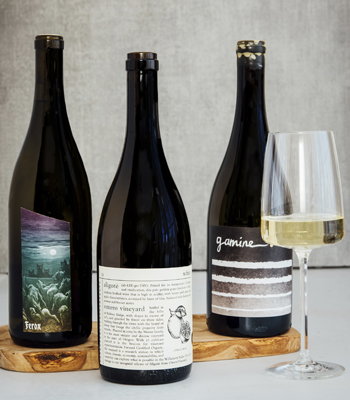Got Aligoté?
New World take on an Old World wine

In a region so famous for particular varietals, other wines from the same place can appear like second-class citizens. Such is the case for Burgundy’s “other white,” Aligoté. When we consider Burgundian wines, we naturally think of Pinot Noir and Chardonnay; but other remarkable wines, like Gamay and Aligoté (al-i-goh-tey), are produced there, too. Aligoté, often in the shadow of its Burgundian sister, Chardonnay, is gaining its own enthusiastic following. With its driving acidity, bright fruit flavors and solid fruit set, more people appreciate the wine’s approachability and intrigue. And Oregon winemakers are taking notice.
Pale straw yellow in color, with hints of gold, Aligoté encompasses a delightful range of aromas, including green apple, white peach, white flowers, lemon, hazelnut and herbs. It forms the base of the classic and tasty Kir cocktail.
Kate Norris of Division Wine Co., Gamine says, “If you love Apéro, then you'll love Aligoté! Spending a good chunk of my life in France, Aligoté has always been a quaffable white to enjoy anytime—especially before dinner or a big family lunch.”
I asked Russell Lichtenthal of Flâneur, “Why Oregon Aligoté?” He jokingly replied, “Why not?” The Willamette Valley has a history of comparing itself to Burgundy. When Flâneur wanted to diversify its portfolio beyond Pinot and Chardonnay, logic dictated that since Gamay, Burgundy’s “other red,” is enjoying popularity, maybe exploring Aligoté also makes sense.
Chad Stock of Minimus Wines and Craft Wine Co. notes, “Aligoté has sound reason to be in the Willamette Valley based on climate, and what we have achieved with Pinot Noir and Chardonnay. Add the Burgundian narrative many Oregon vintners model their wineries after (indicating it could adapt from a marketing perspective) and that we didn’t know anyone who was attempting to grow it, the Aligoté proposition was exciting and mysterious at the time.” So far, the results are promising from farming yields, winemaking adaptation and market/consumer demand.
Some winemakers say the variety expresses terroir well, perhaps more clearly than Chardonnay, meaning the nature of the soil — volcanic, alluvial, loess, sedimentary — will be noticeable in the wine’s taste. That being said, it is punishing in the cellar, with a propensity to display every flaw. On the flip side, if you make it too well, or shorten the lees exposure, the wine tastes too straightforward. The trick remains to nail it by creating a wine that’s linear, acidic, salty and expresses lees with beautiful precision. Luke Wylde, co-owner/winemaker of Statera, agrees, “Aligoté is such a giving variety. The clusters come in as huge bunches with translucent marbles for grapes. The juice itself doesn’t taste like something specific (like Riesling, Gewürztraminer or highly aromatic varieties); instead, it has the malleable quality of reflecting what winemaking was done to it.”
Winegrower Dai Crisp of Temperance Hill Vineyard and Lumos Wine Company recalls his first experience with Aligoté 30 years ago in Paris. He says it was so delicious it had a lasting impact that led to his planting an acre of it on Temperance Hill. This will be the third year for these plants, which harvested enough for a barrel this past vintage.
According to Crisp, “Aligoté is an old variety, much older than Chardonnay, for example, and it has a quality like Pinot Noir that expresses something ancient. I think the Willamette Valley is capable of ripening it correctly and revealing the nuances of its character.”
Flâneur recently decided to plant one acre of Aligoté on a new vineyard site because it grows well in cooler climates and creates wines of great energy and tension. According to Grant Coulter of Hundred Suns Wine and winemaker/director of vineyards for Flâneur, they’d been harvesting exceptional Chardonnay from this hillside, so when they started the discussion about what to plant on this higher-elevation slope with basalt soils, it seemed suitable for white varietals like Aligoté.
Wylde suggests Oregon is capable of growing most grapes if planted in the right spots, while Stock affirms that Aligoté does well in places with thinner soil profiles and little clay depth over the parent material. “The grape variety wants to produce generously, which can be a problem with too much clay and water-holding capacity. I think it does great when restricted in portions of vineyards that may have too poor of soil to support Pinot Noir or other varieties sensitive to vine stress.”
Winemakers agree Aligoté has tremendous food pairing possibilities. Seafood and oysters highlight saline notes, but it’s also great with poultry or roast pork, or, at the end of a meal with fresh or aged cheese. Wylde suggests Waldorf salad, shrimp spring rolls or pork pho. Norris says her first vintage of Aligoté is delicate and feminine — she’s made two vintages so far — so she likes it with bounty from the Oregon Coast this time of year: Dungeness crab, cod, rockfish. Stock contends his Aligoté tastes heavenly with the Quattro Formaggi pizza fresh out of the oven from Pizza Capo in McMinnville. He says their margherita pizza works well also because of the intense fresh basil. The wine has enough acidity to stand up to the tomato sauce, plus the yeast expression from long lees aging in old barrels echoes the sourdough crust. Sounds perfect.










